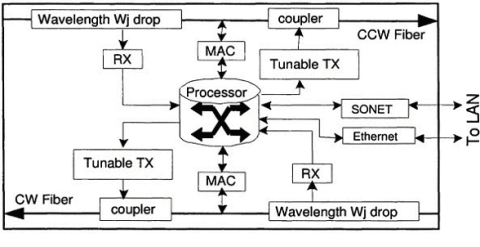Metropolitan area networks (MANs) connect access points within a large geographical area (~100km circumference) to the internet backbone. HORNET is a novel MAN architecture that addresses two fundamental shortcomings in traditional metro networks: (1) efficient transport of the ever-increasing quantity of bursty, best-effort internet traffic, and (2) cost-effective scalability, especially when considering peer-to-peer traffic across a metropolitan area.
In the current implementation of HORNET, each node includes a tunable transmitter and a unique fixed wavelength drop filter. Only the traffic on a node's drop wavelength is converted into the electrical domain -- all other traffic optically bypasses that node. Every node knows exactly what wavelength is dropped at every other node. When a node receives a packet to insert onto HORNET, then, it is responsible for placing it onto the correct wavelength so that it reaches its destination.

